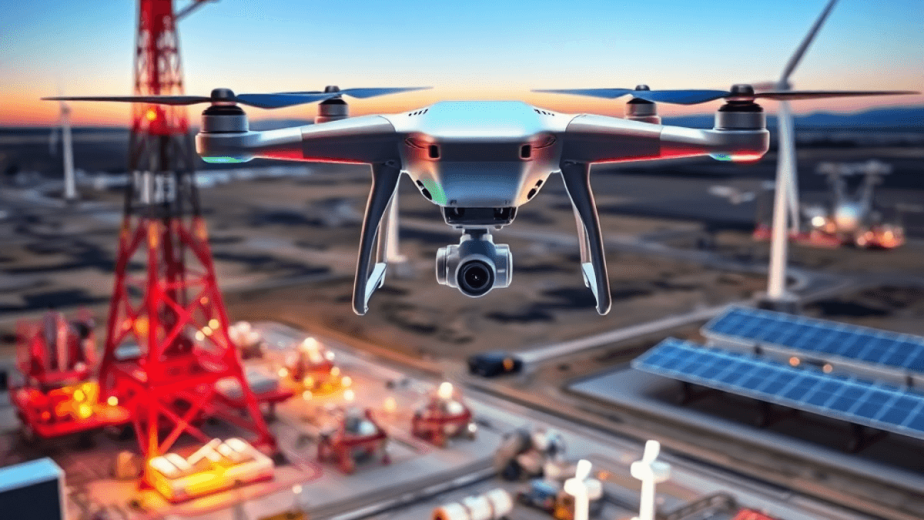Introduction
Reality capture technology has rapidly evolved, becoming a cornerstone of infrastructure management. This innovative approach utilizes advanced tools to create accurate digital representations of physical environments. Key components include:
- Drones and satellites for data collection
- AI-driven analytics for insightful interpretations
- High-precision mapping techniques
In this article, we will explore the emerging trends in reality capture for infrastructure management in 2025. These trends promise to revolutionize the industry through enhanced efficiency, safety, and decision-making capabilities.
Mira Spatial stands out as a leading player in this field, driving innovation with comprehensive solutions designed for various sectors including energy, construction, and local government. Insights from their advancements will illuminate how emerging trends shape the future of infrastructure management. For more information about their groundbreaking work and solutions, you can reach out to them directly through their contact page.
The Role of Advanced Technologies in Reality Capture
Advanced technologies are transforming reality capture, especially with the introduction of Spatial AI and automation.
Automation has revolutionized reality capture workflows by significantly reducing the need for manual intervention in both data collection and processing phases. Through sophisticated automation tools, teams can now streamline their documentation processes while maintaining consistently high accuracy levels and minimizing the potential for human error. The integration of these automated systems with reality capture tools has created a powerful synergy, enabling advanced data analysis capabilities that drive superior project outcomes. This technological convergence delivers real-time insights to stakeholders, fostering enhanced collaboration and communication across project teams. The seamless flow of information allows for immediate access to critical data, enabling faster decision-making and more efficient project execution. This integration represents a significant advancement in how infrastructure projects are managed and monitored, setting new standards for efficiency and accuracy in the industry.
Advanced technologies are not just add-ons; they are crucial for improving efficiency and precision in managing infrastructure.
1. Use of Spatial AI in Reality Capture for Infrastructure Management
Spatial AI refers to the integration of artificial intelligence with spatial data to enhance decision-making processes within construction projects. This technology leverages data from various sources, including Building Information Modeling (BIM) and visual capture tools such as OpenSpace, to provide a comprehensive understanding of job sites.
Key applications include:
- Enhanced Job Site Documentation: Spatial AI automates the capture and analysis of site data, producing accurate documentation that reflects real-time conditions. This level of detail allows teams to maintain an up-to-date record of progress and compliance.
- Data-Driven Decision Making: By analyzing patterns and anomalies in site data, Spatial AI supports proactive decision-making. Stakeholders can identify potential issues before they escalate, leading to more informed project management.
Case studies illustrate these efficiencies:
- A prominent construction firm implemented Spatial AI alongside BIM, resulting in a 30% reduction in rework costs due to improved accuracy in project documentation.
- Another project utilizing OpenSpace reported a 25% increase in productivity as teams accessed real-time information directly from their devices, enabling instant adjustments during the construction phase.
These examples underscore the transformative impact of Spatial AI on infrastructure management, optimizing workflows and enhancing overall project outcomes.
2. How Automation Features Boost Productivity and Quality Assurance
Automation features in modern reality capture tools are transforming how infrastructure management is done, making it more efficient and ensuring high quality. Here’s how:
Key Automation Functionalities
- Automated Data Collection: Tools with sensors and drones can gather data in real-time, greatly reducing the time spent on manual tasks.
- Workflow Automation: By integrating automated workflows, human involvement is minimized, making documentation smoother and ensuring consistency across projects.
- Quality Control Algorithms: Advanced algorithms automatically find mistakes in the data collected, allowing for quick fixes and maintaining top-notch standards.
Benefits for Project Stakeholders
The advantages of these automation features are significant for everyone involved in the project:
- Increased Productivity: With less manual work, teams can concentrate on important tasks instead of repetitive data collection.
- Enhanced Quality Assurance: Automated checks result in fewer mistakes during data gathering, directly affecting project results and reducing costs of redoing work.
Real-World Examples
These benefits are clearly shown in real-life situations. For example, construction companies using automation have reported up to a 30% decrease in project timelines because of better workflow efficiency. The move towards automation not only makes operations more effective but also creates a culture of continuous improvement in infrastructure projects.
3. Rapid Capture Turnaround Times Facilitating Timely Project Execution
Rapid capture turnaround times are transforming infrastructure management, allowing for data acquisition within 15 minutes or less. This speed enhances project execution in several ways:
- Immediate Data Availability: Real-time data collection supports prompt decision-making, essential in fast-paced construction environments.
- Timely Updates Across Phases: Regular updates during design, construction, and maintenance phases ensure that stakeholders stay informed about project status and challenges.
- Minimized Downtime: Quick captures reduce delays caused by lengthy data collection processes, enabling teams to maintain momentum throughout the project lifecycle.
Advanced reality capture solutions leverage technologies such as drones and automated imaging systems to achieve these rapid turnaround times. The ability to swiftly react to site conditions and integrate feedback into ongoing work fosters an environment of agility and responsiveness crucial for successful infrastructure projects. Companies like Mira Spatial are leading the way in this field, continuously innovating and providing valuable insights through their news updates.
4. Enhanced Site Documentation Supporting Effective Risk Management
Effective site documentation plays a crucial role in minimizing construction risks, particularly those related to delays and cost overruns. Clear and precise records ensure that all project stakeholders have access to vital information, which aids in decision-making processes.
Key Benefits of Comprehensive Documentation:
- Reduction of Rework Costs: Accurate documentation helps identify discrepancies before they escalate into major issues, leading to fewer revisions and less wasted time.
- Improved Project Outcomes: Well-maintained records enhance accountability among team members, facilitating smoother communication and coordination across departments.
Implementing advanced reality capture technologies allows for more efficient data collection and storage, contributing to comprehensive site documentation. These innovations not only streamline the tracking of project milestones but also support effective risk management strategies. By maintaining an organized repository of site records, teams can respond swiftly to unforeseen challenges, enhancing their ability to adhere to timelines and budgets.
Harnessing these tools enables infrastructure management professionals to establish a proactive approach towards risk reduction, ultimately paving the way for successful project execution.
5. Enterprise-Grade Security Features Safeguarding Sensitive Infrastructure Data
In an era of increasing digital threats, enterprise-grade security has become a cornerstone for platforms utilized in reality capture. Key measures include:
- Advanced Permission Controls: Ensure that only authorized personnel access sensitive information. This mitigates risks associated with data leaks and unauthorized alterations.
- Encryption Protocols: Protect data both at rest and in transit. Encrypting sensitive infrastructure data prevents interception during transmission, safeguarding it from cyber threats.
Compliance standards such as ISO/IEC 27001 and SOC2 are critical in maintaining robust data protection frameworks. Adherence to these standards not only helps in avoiding legal repercussions but also builds trust among stakeholders.
As Emerging Trends in Reality Capture for Infrastructure Management 2025 evolve, prioritizing digital security will be essential for protecting sensitive infrastructure information from breaches and ensuring the integrity of project data.
6. Visual Analytics Empowering Informed Decision-Making Throughout Project Lifecycles
Visual analytics tools play a crucial role in enhancing project engagement by transforming raw data into understandable visual formats. Stakeholders can gain valuable insights into construction progress through interactive dashboards and graphical representations, facilitating informed decision-making.
Key benefits include:
- Proactive Issue Resolution: Real-time visualizations help identify potential problems early, allowing teams to address issues before they escalate.
- Efficient Resource Allocation: By analyzing visual data, project managers can optimize resource distribution, ensuring that manpower and materials are effectively utilized.
Real-World Implementations
Several infrastructure projects have successfully integrated visual analytics:
- Smart Cities Initiative: A city implemented visual analytics to track construction timelines and budget adherence across multiple sites. This led to a 20% reduction in project delays.
- Highway Upgrades: A state DOT used visual dashboards to monitor traffic patterns and construction impacts, resulting in improved safety measures and reduced congestion during road works.
These examples showcase how visual analytics not only streamline workflow but also enhance collaboration among teams, driving successful outcomes in complex infrastructure projects.
7. Cost Savings from Using Reality Capture Technologies
Using reality capture technologies can save a lot of money in managing infrastructure. Here are the main areas where savings can be achieved:
- Fewer Site Visits: With advanced reality capture tools, project teams won’t need to visit sites as often, which means less travel expenses and time saved.
- Lower Insurance Premiums: By using accurate documentation and analytics to manage risks better, companies can show that they have improved safety measures and potentially lower their insurance costs.
- Reduced Rework Costs: Collecting high-quality data upfront helps with better planning and execution, which in turn reduces expensive rework caused by mistakes or miscommunication.
- Better Resource Allocation: Streamlined workflows allow project managers to use resources like labor and materials more efficiently, resulting in cost savings.
These reasons make a strong argument for why reality capture technologies should be included in infrastructure management strategies. By adopting these innovative solutions, organizations can not only improve their operations but also strengthen their financial performance.
Conclusion: Embracing the Future with Reality Capture Innovations
The future of infrastructure management is set to change, thanks to the new trends in reality capture for 2025. It’s important for professionals in this field to understand the potential benefits these advancements can bring:
- Enhanced efficiency through technologies like Spatial AI
- Streamlined processes that reduce risks and costs
- Improved decision-making supported by visual analytics
To stay competitive in this quickly changing environment, it’s crucial to be open to new solutions. Companies like Mira Spatial are leading the way by offering comprehensive tools and services that redefine how infrastructure is managed.
Investing in these technologies not only prepares organizations for future challenges but also places them at the forefront of industry evolution. This commitment to adopting reality capture innovations will undoubtedly shape a more efficient, cost-effective, and resilient infrastructure sector.



